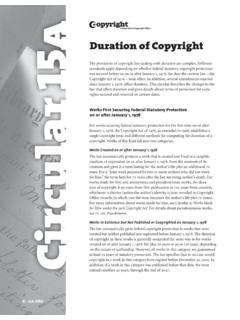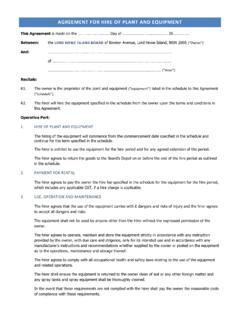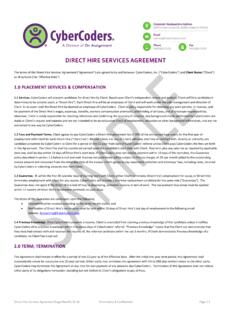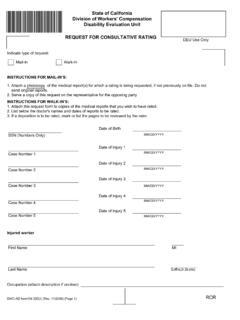Transcription of FEATURE - Deloitte
1 FEATUREA rchitecting an operating modelA platform for accelerating digital transformationAnne Kwan, Maximilian Schroeck, and Jon KawamuraPART OF A Deloitte SERIES ON DIGITAL INDUSTRIAL TRANSFORMATION2 FIGURE 1 What makes a strategic transformation succeed or fail?Sources: Marcia Blenko, James Root, and Nader Elkhweet, When weak operating models happen to good strategy, Bain Insights, April 2, 2015; Ron Carucci, Executives fail to execute strategy because they re too internally focused, Harvard Business Review, November 13, Insights | of UNSUCCESSFUL TRANSFORMATIONSGap between strategy and execution; culprit is usually an obsolete/misaligned operating modelCharacteristics of SUCCESSFUL TRANSFORMATIONS64 percent build their budgets around and allocate specific company resources to their strategies60 percent do not link budgets to strategies, meaning resources and capabilities are not aligned to goals77 percent translate their strategy into operational mechanisms, monitor progress, and make changesExecutives leave old organization designs in place, inhibiting change in responsibili-ties and processesCompanies with top-quartile operating model indicators have five-year CAGRs 120 basis points higher than those in the bottom quartileIntroductionAcross a broad spectrum of sectors, artificial intel-ligence (AI), digital, the Internet of Things (IoT)
2 , process automation, and other technologies are shifting value from manufacturers and distributors to companies that operate end-to-end platforms and provide outcomes as-a-service. For many enterprises, that means constant change and dis-ruption and a growing threat of market , revising their five-year plans every quar-ter, are seeking ways to constantly reinvent their companies to stay ahead of the pack, with competi-tors of varying capabilities and scale and customers who expect more for less. And for many companies, the answer is large-scale global transformation. Indeed, 80 percent of CEOs in one study claim to have transformations in place to make their busi-nesses more digital; 87 percent expect to see a change in their operating models within three leaders see establishing those operating mod-els as their top challenge in achieving digital So how might they move forward?
3 Reviewing transformations across industries reveals a common theme: Successful transforma-tions realign the organization to a singular vision; failed endeavors typically do not. In short, an orga-nization has a far better chance at succeeding when an operating model or how an organization cre-ates value is aligned to the strategy. And this means that, for transformations to succeed, leader-ship teams should examine and possibly revise their organizations operating models. (See fig-ure 1.)BALANCING GROWTH AND RISKG iven the pace of change and the volatility in the impact of potential disruptors executives may Many transformation efforts begin with reinventing the operating model. How to keep such a big project on track? This article, fourth in a series, explores how successful transformations align models with clear an operating model to accelerate digital transformation23struggle to determine where to place bets, how much to invest, and when to do it.
4 Wait too long and they risk seeing market value quickly erode; invest inefficiently or ineffectively and they could face a cash crunch or investor backlash. Management teams must increasingly balance growth and risk. We consistently see executives try to solve for six questions each of which can funda-mentally pull the organization in a different direction, all of which are critical in the effort to win in the digital economy. Executives often ask themselves, How do we: Grow amid increasing market and customer expectations Respond faster to market and competitive disruptions Simplify organizational processes, both inter-nal and external Maximize returns on limited financial and human capital Incubate and test new products and technologies Pivot to competitive business modelsThe good news for companies born before the digi-tal era is that they often quickly understand the value in transforming to agile, adaptive, and responsive enterprises because they already have the other intangibles in place.
5 Strong brands, an entrenched customer base, established sales meth-ods, and partners suppliers, distributors, and driving these changes, though, depends on executives addressing a range of orga-nizational barriers and risks particularly functional silos, incomplete enterprise data, and a product-out (versus a market-in) philosophy of value creation. In our experience, a well-designed and purposefully executed enterprise operating model can help companies balance growth with risk and overcome organizational one global consumer technology company, exec-utives set out to unify the organizational vision across AI and machine learning (ML) technology. The company made a strategic decision to bolster its capabilities through acquisition of a startup and hiring new talent, combining teams dealing with ML and voice-assistant technology. The changes resulted in unified leadership and aligned incen-tives across development functions and product lines; the company has since embedded its AI offering into new products, extended the reach of the operations performed, and launched new soft-ware centered around AI and operating modelBefore addressing the value of an operating model, we must first acknowledge the potential for wide-spread confusion and disagreement: Poll any number of executives, and you ll likely find yourself with as many definitions of operating model.
6 But most commonly, operating model transformations are associated with cost takeouts or organizational redesigns box and wire diagrams. While these can be byproducts of an operating model shift, the common associations are myopic and discount the full value. Our definition of an operating model is simple but comprehensive: An operating model represents how value is created by an organization and by whom within the an operating model to accelerate digital transformation34To better illustrate this, figure 2 depicts an example of an operating model; each box represents a unique set of capabilities aligned to the enterprise s strategy, with skilled leadership teams, tailored metrics, unique investment profiles, and tight coor-dination across the value chain. This illustration lays out the characteristics of this example s operating model: Centralized strategic planning functions to set a unified direction for the enterprise Emphasis on customer experience with consoli-dated marketing, account management, and customer experience functions Independent business lines (consumer, small/medium businesses, enterprise) responsible for product, operations, etc.
7 Close partnerships between product and sales teams using product-aligned sales teams, with some overlap Separate product and business incubator with end-to-end responsibility and direct access to C-suite Managed services overlay for SMB and enterprise customers Digital enablement center of excellence (CoE) to drive companywide adoption of tools and technologies Centralized business ops teams likely off-shore to drive economies of scale Robotics and AI CoE to drive operational effi-ciencies in mid- and back-office operationsMost critically, an organization s operating model must be inextricably linked to the corporate and FIGURE 2 Example operating modelOperating model exampleShared services: IT, real estate, HR, knowledge management, corporate finance, and accounting CXO office: Strategy, corporate development, digital strategyBusiness ops: CPQ, billing, customer supportSales strategy and marketingNew product incubatorConsumer salesSMB salesEnterprise salesConsumerproduct/servicesSMBproduct/ servicesEnterpriseproduct/servicesDigita l enablement center of excelle nceCorporate marketing, customer experience, account managementManaged servicesTransformation office (activated as needed)Robotics and AI center of excellence Source: Deloitte Insights | an operating model to accelerate digital transformation45business-unit strategy and varying business mod-els.
8 The operating model is the anchor for the enterprise and is critical to the strategy s effective-ness and longevity. And understanding how your organization maps onto the model is key to an effective digital MODEL DESIGNL eaders should develop a clear sense of their stra-tegic ambitions where to play and how to win and the business models they wish to employ, including target customer segments, channels, pricing, and delivery models, since both the strat-egy and business model directly influence the operating model design. Organizations that try to short-cut their way to a new operating model may find the design to be ineffective and the implemen-tation lacking employee traction or, worse, dilutive to global entertainment company aimed to share technology across its business units to improve customer experience. In 2013, for the first time in nine years, the company effected a large reorgani-zation: combining console and handheld divisions.
9 The change was driven by criticism about a lack of a unified vision related to previous launches. Executives intended the new structure to promote sharing of technology across groups, and thus far it has worked, with the company launching its most successful console to : Deloitte Insights | 3 Digital industrial transformation framework Digital industrial transformation begins with strategy, which is carried through to redesigning talent, transforming processes, and retooling technology. Leaders screen each decision to confirm that it will contribute to agility, promote digital adoption, and deliver value to customers. StrategyBusiness modelCapabilitiesOperating modelPeople, process, and technologyAGILE MINDSETDIGITAL ADOPTIONCUSTOMER SUCCESS1. What are our winning aspirations? (What do we want our company to be?)2. Where will we choose to play, and how will we win in these markets , which customers and pricing?
10 3. What capabilities are needed? Which capabili-ties must be built, refined, or bought?4. How should capabilities be configured? Where should they be executed? Who has ownership and decision rights?5. What business processes, technology, and management systems are required?Architecting an operating model to accelerate digital transformation56 What work needs to be done?In moving forward with a digital transformation, the first step is to identify the holistic set of capa-bilities required to meet the enterprise s strategic ambitions. The capability set should include both existing capabilities and new ones (as needed) and address front-, mid-, and back-office functions across all product lines. For example, product strategy is a capability that creates product road maps to realize customer requirements; campaign management is a capabil-ity that launches, measures, and reports on the success of marketing campaigns.












![FORM 30 [See Rule 55(2) and (3)] APPLICATION FOR ...](/cache/preview/2/5/7/3/3/2/4/e/thumb-2573324e7e69fa9abb4cf98f5bc0a1cc.jpg)



